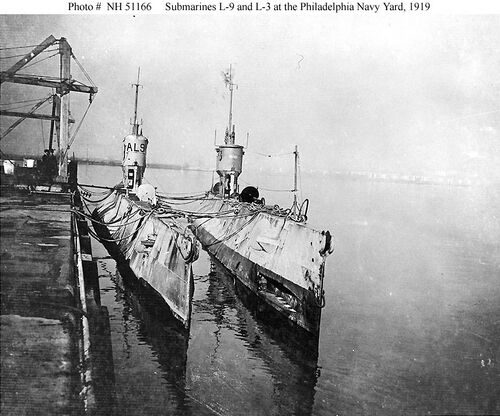General L-boat photos
Video from the YouTube British Pathé channel.

A small photo of three L-boats at an unknown location, probably in the spring or summer of 1916. This is definitely a pre-WWI photo, as these boats do not have the installed "chariot" style bridge structures.
Photo in the private collection of Ric Hedman

L-2, L-4, and L-9 moored together with M-1 (Submarine No. 47) at the Fore River Shipbuilding fitting out pier, April 5, 1916. All of the boats shown here are in various stages of completion. None have been commissioned. The L-boats were all of the standard Electric Boat single hull design, but M-1 was built with a radically different double hull. It was essentially an experiment that ultimately did not work out well.
Photo courtesy of the Submarine Force Library & Museum.

L-3 (Submarine No. 42) and L-4 (submarine No. 43) at the Boston Navy Yard, Charlestown, MA. in the fall of 1916. Both boats had arrived for a post-commissioning overhaul that lasted about five weeks. As built, the L-class did not have the 3"/23 caliber deck gun. They would be installed during a pre-deployment overhaul in Philadelphia in the summer of 1917. Also, at this point in their service these boats did not have the permanent metal chariot bridge structures, using instead a removable pipe-frame and canvas enclosure.
Photo courtesy of the Massachusetts Digital Commonwealth.

Photo in the private collection of Ric Hedman

Photo in the private collection of Ric Hedman
L-4, L-10, and L-11 are featured in this historical footage, filmed while the boats were deployed to Berehaven, Ireland during WW I. There are great shots of the boats underway on the surface, and a few diving, including one that shows the bow planes being rigged out.
Video from the YouTube Critical Past channel.

Photo in the private collection of Ric Hedman

Photo courtesy David Wright, Navsource, Destroyer Archives Manager, Yard & District Archives Manager.

Photo contributed by Patricia Lynn.

L-9 and L-3 moored in a nest at the Philadelphia Navy Yard, February 1919. These boats had just returned from the war zone and were looking pretty weary. They were in need of a thorough overhaul. Note that the shutter door is open for #1 torpedo tube on the L-3. It appears that the muzzle door for the tube is shut, as it would need to be to prevent accidental flooding. Most likely the mechanical linkage between the shutter door and the muzzle door has been disengaged for maintenance.
Photo NH 51166 courtesy of the NHHC.

Shortly after the photo above was taken, the nest was expanded by adding L-11 to the inboard side. This photo shows the three boat nest being warped out so that another L-boat in the background can be inserted into the inboard position. Philadelphia Navy Yard, February 1919.
Photo NH 51168 courtesy of the NHHC.

K-3 (SS-34) and an unidentified K-boat moored outboard of L-11, L-2, L-3, and L-9 at the Norfolk Navy Yard, Portsmouth, VA. approximately 1923. These boats were all decommissioned and would soon be moved to Philadelphia and later scrapped. Note that none of the chariot bridge fairwaters on the L-boats are exactly the same.
A few years after the end of WW I, the Navy decommissioned a large percentage of the coastal patrol submarines for two reasons. The first was to keep the United States in compliance with the post war treaty limits on tonnage of submarines. The second was that the Navy was rapidly shifting emphasis away from the coastal operations mindset for submarines and towards an open ocean, long range fleet submarine concept. WW I experience had shown how far behind technologically our submarines were when compared to the German U-boats. WW I had begun a paradigm shift in USN mindset.
Photo in the private collection of Ric Hedman
Page created by:
Ric Hedman & David Johnston
1999 - 2023 - PigBoats.COM©
Mountlake Terrace, WA, Norfolk, VA
webmaster at pigboats dot com
